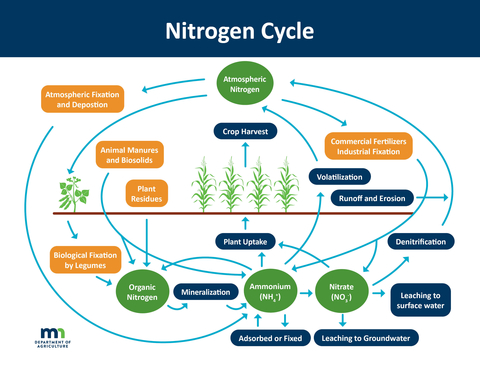Source: Elizabeth Griebel, ANR Extension Intern for Wright, McLeod, and Meeker Counties
Having good nitrogen management in the spring when plants are small, is beneficial in avoiding nutrient deficiency later on. Timing, rate, and placement are all important factors when making nitrogen applications. The Minnesota Department of Agriculture (MDA) and University of Minnesota Extension promote using fertilizer best management practices (BMPs). The purpose of the BMPs is to be practical, to protect water quality while maintaining farm profitability, and to refer to practices relating to timing, rate and placement of the fertilizer application (Minnesota Department of Agriculture.)
Corn shows nitrogen deficiency when it turns yellowish-green and grows with spindly stalks. It begins on the lower leaves and progresses up as the nitrogen deficiency continues. It begins as v-shaped yellowing and will start at the tip of the leaf and progress down the midrib and toward the leaf base.
Best management practices for the use of nitrogen in Minnesota are different in each region, as there are a variety of soil types and factors that play a role. Looking at your specific region of Minnesota and soil types are helpful tools when applying nitrogen. Acknowledging these differences will lead to more efficient nitrogen management and maximum profit. (Professor John Lamb, Department of Soil, Water, and Climate). Understanding the nitrogen cycle is also an important factor, as shown in the figure below provided by the Minnesota Department of Agriculture. The nitrogen cycle shows how nitrogen moves through fixation, deposition, and denitrification, all through plant uptake and crop harvest. Many factors including runoff and erosion, plant residues, and how all these factors interact in the nitrogen cycle have an impact on nitrogen management for the season.
The United States Environmental Protection Agency (EPA) shares the many ways farmers can reduce nutrient losses from their operation by maintaining ground cover. Farmers are able to do this by planting cover crops to make nutrients in the soil less susceptible to erosion and loss. Other conservation practices include using conservation drainage practices and field buffers. An important management tool is finding the nutrient management technique that works best for one’s operation and applying nitrogen and nutrients in the right amounts, at the right time, with the right placement (EPA).
Learn more about nitrogen management and University of Minnesota recommendations. BMPs are specific to different regions of the state and address fertilizing corn, wheat, sugarbeets, potatoes, and other crops in Minnesota. For further information visit Minnesota Board of Water and Soil Resources to learn more about finding the right time, rate, and source.


